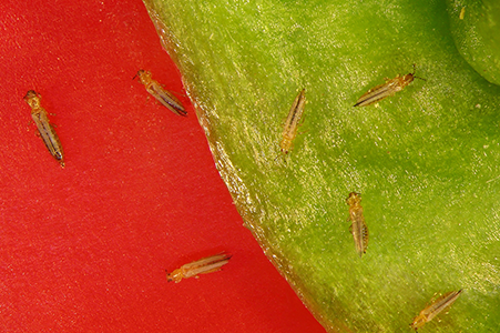Feel like something is sucking the life out of your plants?
There are some insects that like to feed on your plants’ leaves by piercing and draining the life out of them. The result is a leaf surface that becomes discolored or unattractively flecked or a flower that hesitates to finish blooming. No one wants that.
One such insect is a thrips
Let’s learn a little bit more about this life-sucking plant pest and how to prevent thrips to save your precious plants.
What are Thrips?

Thrips are very small, yellow-brown or black insects commonly found on flowers in summertime. As thin as a needle, most of these insects are less than 5 millimeters long. They all have one thing in common: They crave your plant’s sap.
Though many thrips are winged, they are often reluctant fliers unless there’s a thunderstorm. Then, they’ll take flight in droves, which is why they are also commonly known as thunderflies. Also, you usually never find one thrips on its own; as very social creatures, they are generally found in groups.
Thrips Life Cycle
There are more than 6,000 species of thrips across the world, so the specific thrips life cycle depends on the species of thrip, as well as the location and host plant.
Generally, though, adults overwinter in plant bark, debris, or other material. In early spring, they become active and make slits in leaf tissue to lay their eggs. One female can lay up to 25 to 50 eggs at one time. The eggs hatch three to five days later, and then they feed on your plant sap.
Baby thrips mature to adulthood quickly and can reproduce themselves within three weeks, which is how populations can build quickly.
While thrips adults have short one-month lives, they can have up to 15 generations per year outdoors, keeping thrips present throughout the growing season.
How to Identify Thrips
Thrips control starts with knowing what these pests look like.
Many species of thrips like to feed within plant buds or curled leaves, which makes them a challenge to detect. Also, because they are so small, they can be difficult to actually see until infestations become quite large.
If you suspect thrips, you can place a piece of white paper under the leaves or flowers of the plant and shake the plant. If there are thrips on your plant, some will fall off and their dark, skinny bodies will be easier to see on the white paper.
Thrips Damage: What Does Thrips Damage Look Like?

The first sign of a thrips infestation on your plants is typically yellow or bleached spots on your plant’s leaves. You may also see deformed leaves or splotches on flower petals.
As the infestation worsens, thrips leaf damage shows up in a silvery thin look with black spots. This is the culmination of thrips sucking the plant sap from the leaves and then leaving their excrement behind.
Thrips damage on plants then advances to the stage where leaves and petals may become so thin, they wilt, die, and finally drop off of the plant.
Plants Commonly Affected by Thrips
Thrips feed on woody plants, flowers, fruits, and shade trees. Some of the most commonly impacted include:
- Azalea
- Dogwood
- Gardenia
- Hibiscus
- Magnolia
- Maple
- Viburnum
- Impatiens
- Chive
- Fig
- Iris
- Rose
- Gladiolus
Thrips Control and Prevention
Because thrips damage can resemble that of mites or lace bugs, it’s important to know you have thrips before taking action.
Learning how to prevent thrips begins with keeping plants moist since thrips are usually drawn to those that are too dry.
Early detection and monitoring are important here. This means you are regularly inspecting your plants for thrips and taking action only if you properly identify and detect their presence and damage.
How to Get Rid of Thrips

Once you spot these pests, thrips control involves using insecticidal soaps and low-toxicity contact insecticides. With any pesticide, always read and follow label directions, using only those products specifically labeled for the pest and plant that needs treatment. Soaps can damage plants and blooms, especially in high temperatures. Read all label instructions carefully prior to use.
Unfortunately, because thrip eggs are protected in plant leaves and their life cycles are brief, thrips pest control can be something you have to continue through the growing season. Contacting a certified landscape and tree care professional who can properly identify and target the pest can also give you a faster plan of attack and help prevent any additional and unnecessary plant damage.





